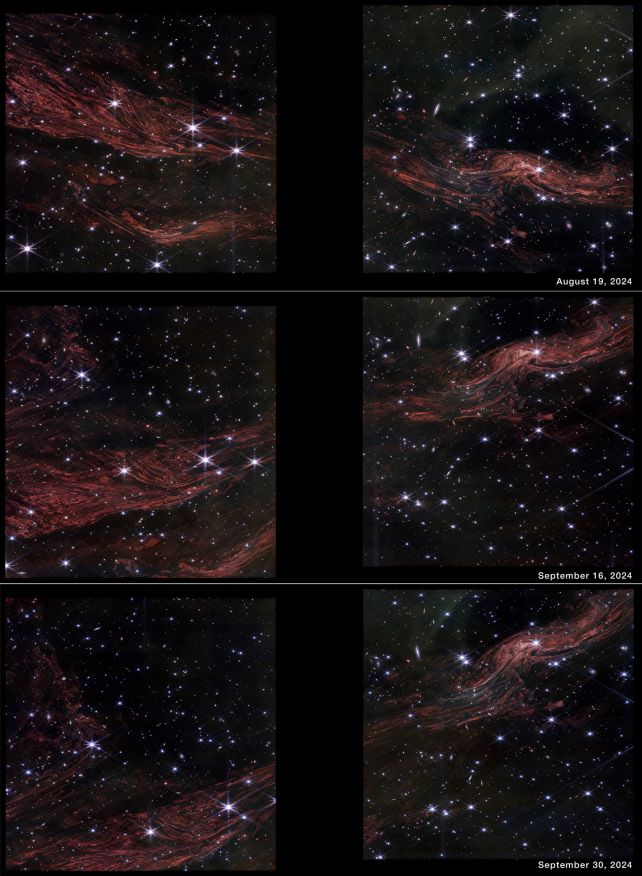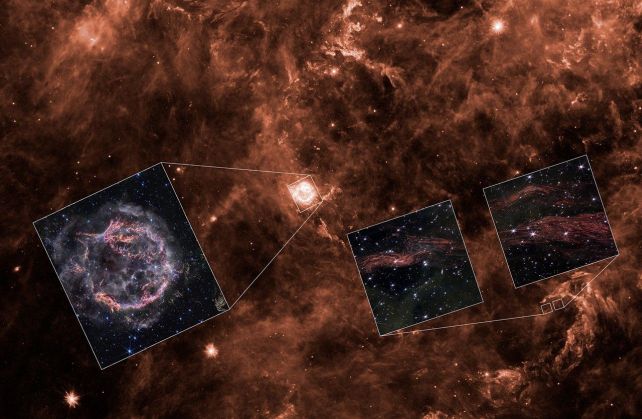The intricate swirls and streaks of dust floating among the stars have just been revealed in stunning detail.
In new images from JWST, we finally see beautiful details of the flow and turbulence of the interstellar medium near a star we saw explode a few hundred years ago.
As the light from the explosion, now called Cassiopeia A, expanded outward, it reflected and heated the thin dust it passed through, creating a faint, red glow.
The material is so thin and the glow so dim that its true complexity has largely escaped us. Thanks to JWST’s power to see faint, red light, we are finally gaining a better understanding of the structure of the interstellar medium.
What’s even more incredible is that we can see changes in the structure at the scale of to dawn. JWST took multiple images of a grove in the dust cloud near Cassiopeia A in August and September 2024 and saw significant changes as light moved through the woodgrain-like streaks, creating a phenomenon known as a light echo.
frameborder=”0″ allow=”accelerometer; autoplay; clipboard writing; encrypted media; gyroscope; picture-in-picture; web-share” referrerpolicy=”strict-origin-when-cross-origin” allowfullscreen=”allowfullscreen”>
“We see layers like an onion,” says astronomer Josh Peek of the Space Telescope Science Institute in the US. “We think every dense, dusty area we see, and most of the ones we don’t see, looks like this on the inside. We’ve just never been able to look inside it before.”
Light echoes can produce some of the most beautiful sights in the Milky Way. They are created when something produces a flash of light that radiates into space.
If that light encounters a physical barrier, such as clouds of cosmic dust, it will reflect and arrive at a different time than the initial burst; just like a sound echo, but with light. We can use these light echoes to map and understand space and the objects within it.
So far, most of the light echoes we have detected come from very bright events or very thick dust close to the light source, as we see in the star V838 Monocerotis. Thinner dust, further from the source, is a lot harder to see.
Anyway, seeing things we couldn’t see before is what JWST does. The infrared telescope is optimized to see the faint red light that other instruments cannot pick up; so astronomers turned it into a trail of dust near and behind, but not related to, Cassiopeia A, a star that humanity saw explode from 11,000 light-years away in the 1670s.

This grove was identified as a light echo by NASA’s now retired Spitzer Space Telescope. But Spitzer didn’t have JWST’s resolution.
Still, “we were quite shocked to see this level of detail,” says astronomer Jacob Jencson of the California Institute of Technology.
Perhaps most surprising was the discovery that the medium is arranged in densely packed sheets of material, with knots and whorls, somewhat like the knots you might see in the grain of a tree. The researchers were able to see details in these sheets down to a scale of about 400 astronomical units, or 400 times the distance between the Earth and the sun.
According to the researchers, these structures may be related to magnetic field lines that run through space. If this is the case, studying the evolution of light echoes opens a new window in the study of magnetized turbulence.

“This is the astronomical equivalent of a medical CT scan,” says astronomer Armin Rest of the Space Telescope Science Institute. “We made three slices at three different times, which will allow us to study the real 3D structure. It will completely change the way we study the interstellar medium.”
Furthermore, in-depth analyzes of the observations will undoubtedly take place.
In the meantime, two presentations, one led by Jencson and the other by Peek, have taken place at the 245th meeting of the American Astronomical Society. The summaries can be found here and here.


